stop start MAZDA MODEL 3 4-DOOR 2007 User Guide
[x] Cancel search | Manufacturer: MAZDA, Model Year: 2007, Model line: MODEL 3 4-DOOR, Model: MAZDA MODEL 3 4-DOOR 2007Pages: 402, PDF Size: 5.12 MB
Page 137 of 402

Black plate (137,1)
NOTE
lWhen driving slowly, the gears may
not shift up depending on vehicle
speed.
lIn manual shift mode, gears do not
shift up automatically. Don't run the
engine with the tachometer needle in
the RED ZONE. If the tachometer
needle enters the RED ZONE, you
may feel engine-braking because the
fuel delivery will be stopped to
protect the engine. However, this
does not indicate an abnormality.
lWhen depressing the accelerator
fully, the transaxle will shift to a
lower gear, depending on vehicle
speed.
Manually Shifting down (M5
*→ M4 →M3 →M2 →M1)
To shift down to a lower gear, tap the shift
lever forward (
) once.
* 2.3-liter engine model
WARNING
Do not use sudden engine braking on
slippery road surfaces or at high
speeds:
Shifting down while driving on wet,
snowy, or frozen roads, or while
driving at high speeds causes sudden
engine braking, which is dangerous.
The sudden change in tire speed could
cause the tires to skid. This could lead
to loss of vehicle control and an
accident.
Be sure to leave the shift lever in 1 or
R position and set the parking brake
when leaving the vehicle unattended:
Otherwise the vehicle could move and
cause an accident.
NOTE
lWhen driving at high speeds, the
gear may not shift down depending
on vehicle speed.
lDuring deceleration, the gear may
automatically shift down depending
on vehicle speed.
lWhen depressing the accelerator
fully, the transaxle will shift to a
lower gear, depending on vehicle
speed.
Second gear fixed mode
When the shift lever is tapped back (
)
while the vehicle is stopped or driven at
the following speeds, the transaxle is set
in the second gear fixed mode.
2.0-liter engine model:
14 km/h (8 mph) or less
Driving Your Mazda
Starting and Driving
5-15
Mazda3_8V66-EA-06F_Edition3 Page137
Wednesday, August 23 2006 11:19 AM
Form No.8V66-EA-06F
Page 138 of 402

Black plate (138,1)
2.3-liter engine model:
20 km/h (12 mph) or less
The gear is fixed in second while in this
mode for easier starting and driving on
slippery roads. If the shift lever is tapped
back (
) or forward () while in the
second gear fixed mode, the mode will be
canceled.
Shifting specification (2.0-liter engine
model)
Shifting up
If the vehicle speed is lower than the
speed specified for each gear, the gear
cannot be shifted up to a higher gear.
Gear Vehicle speed
M1 →M2 You can shift up to M2 whether
the vehicle is stopped or moving.
M2 →M3 20 km/h (12 mph)
M3 →M4 40 km/h (24 mph)
Shifting down
If the vehicle speed is higher than the
speed specified for each gear, the gear
cannot be shifted down to a lower gear.
Gear Vehicle speed
M4 →M3 180 km/h (112 mph)
M3 →M2 119 km/h (74 mph)
M2 →M1 47 km/h (30 mph)
During deceleration, the gears shift down
automatically when speed is reduced to
the following:
Gear Vehicle speed
M4 →M3 36 km/h (22 mph)
M3 or M2 →M1 12 km/h (7 mph)
NOTE
The gear does not shift down to M1
automatically while in the second gear
fixed mode. If the vehicle is kicked down at the
following speeds or lower, the gears shift
down automatically:
Gear
Vehicle speed
M4 →M3 170 km/h (105 mph)
M3 →M2 72 km/h (44 mph)
Shifting specification (2.3-liter engine
model)
Shifting up
If the vehicle speed is lower than the
speed specified for each gear, the gear
cannot be shifted up to a higher gear.
Gear Vehicle speed
M1 →M2 You can shift up to M2 whether
the vehicle is stopped or
moving.
M2 →M3 20 km/h (12 mph)
M3 →M4
33 km/h (21 mph)
M4 →M5
Shifting down
If the vehicle speed is higher than the
speed specified for each gear, the gear
cannot be shifted down to a lower gear.
Gear Vehicle speed
M5 →M4 191 km/h (118 mph)
M4 →M3 137 km/h (85 mph)
M3 →M2 89 km/h (55 mph)
M2 →M1 44 km/h (27 mph)
During deceleration, the gears shift down
automatically when speed is reduced to
the following:
Gear Vehicle speed
M5 or M4 →M3 30 km/h (18 mph)
M3 or M2 →M1 10 km/h (6 mph)
5-16
Driving Your Mazda
Starting and Driving
Mazda3_8V66-EA-06F_Edition3 Page138
Wednesday, August 23 2006 11:19 AM
Form No.8V66-EA-06F
Page 139 of 402

Black plate (139,1)
NOTE
The gear does not shift down to M1
automatically while in the second gear
fixed mode.
If the vehicle is kicked down at the
following speeds or lower, the gears shift
down automatically:
Gear Vehicle speed
M5 →M4 182 km/h (113 mph)
M4 →M3 133 km/h (82 mph)
M3 →M2 48 km/h (30 mph)
M2 →M1 12 km/h (7 mph)
Recommendations for shifting
Upshifting
For normal acceleration and cruising, we
recommend these shift points.
(2.0-liter engine model)
Gear Vehicle speed
M1 to M2 24 km/h (15 mph)
M2 to M3 40 km/h (25 mph)
M3 to M4 65 km/h (40 mph)
(2.3-liter engine model) Gear Vehicle speed
M1 to M2 24 km/h (15 mph)
M2 to M3 40 km/h (25 mph)
M3 to M4 65 km/h (40 mph)
M4 to M5 73 km/h (45 mph)
Downshifting
When you must slow down in heavy
traffic or on a steep upgrade, downshift
before the engine starts to overwork. This
gives better acceleration when you need
more speed.
On a steep downgrade , downshifting
helps maintain safe speed and prolongs
brake life.
q Driving Tips
Passing
For extra power when passing another
vehicle or climbing steep grades, depress
the accelerator fully. The transaxle will
shift to a lower gear, depending on vehicle
speed.
Climbing steep grades from a stop
To climb a steep grade from a stopped
position:
1. Depress the brake pedal.
2. Shift to D or M1, depending on the
load weight and grade steepness.
3. Release the brake pedal while gradually accelerating.
Descending steep grades
When descending a steep grade, shift to
lower gears, depending on load weight
and grade steepness. Descend slowly,
using the brakes only occasionally to
prevent them from overheating.
Driving Your Mazda
Starting and Driving
5-17
Mazda3_8V66-EA-06F_Edition3 Page139
Wednesday, August 23 2006 11:19 AM
Form No.8V66-EA-06F
Page 148 of 402
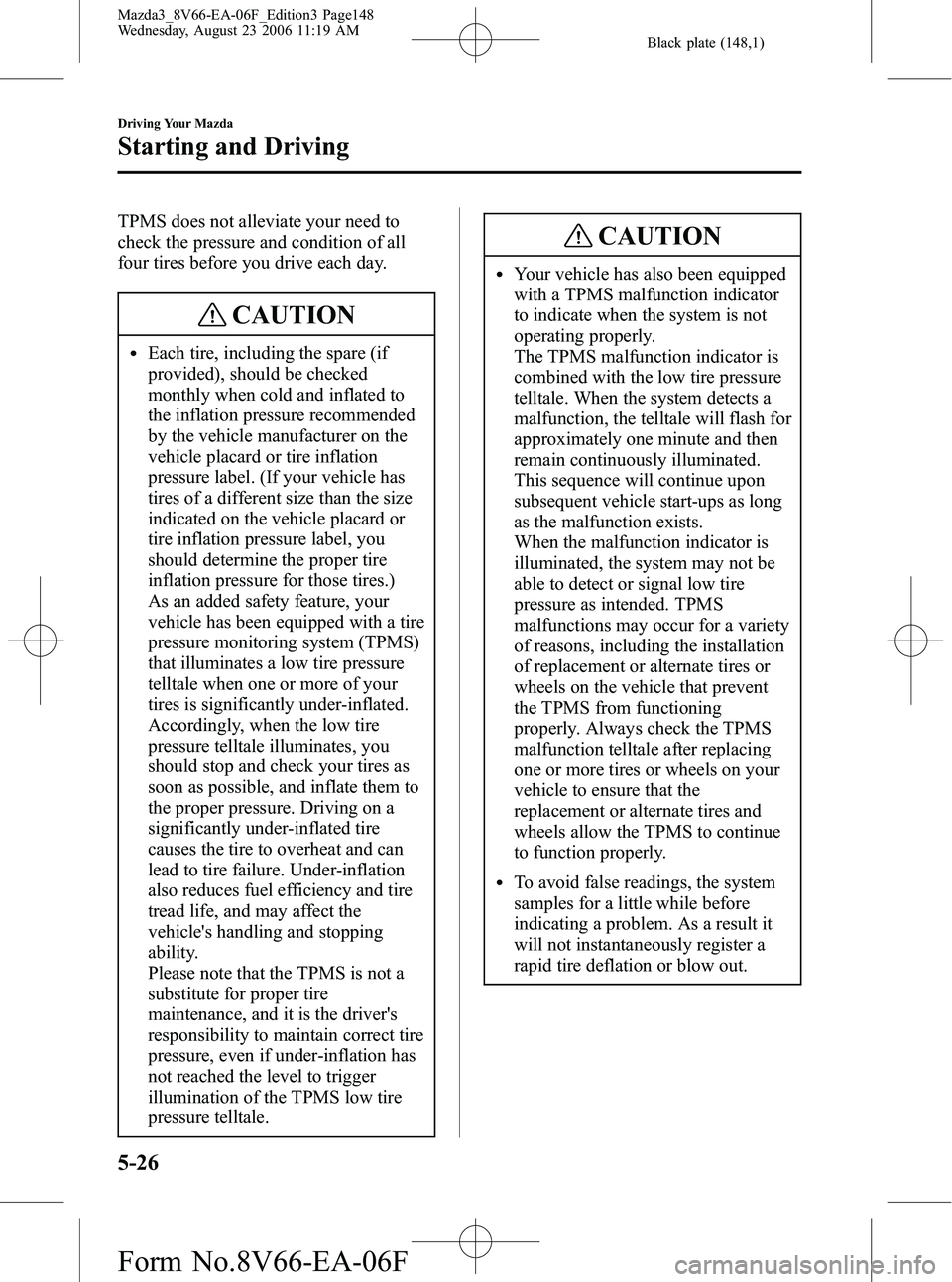
Black plate (148,1)
TPMS does not alleviate your need to
check the pressure and condition of all
four tires before you drive each day.
CAUTION
lEach tire, including the spare (if
provided), should be checked
monthly when cold and inflated to
the inflation pressure recommended
by the vehicle manufacturer on the
vehicle placard or tire inflation
pressure label. (If your vehicle has
tires of a different size than the size
indicated on the vehicle placard or
tire inflation pressure label, you
should determine the proper tire
inflation pressure for those tires.)
As an added safety feature, your
vehicle has been equipped with a tire
pressure monitoring system (TPMS)
that illuminates a low tire pressure
telltale when one or more of your
tires is significantly under-inflated.
Accordingly, when the low tire
pressure telltale illuminates, you
should stop and check your tires as
soon as possible, and inflate them to
the proper pressure. Driving on a
significantly under-inflated tire
causes the tire to overheat and can
lead to tire failure. Under-inflation
also reduces fuel efficiency and tire
tread life, and may affect the
vehicle's handling and stopping
ability.
Please note that the TPMS is not a
substitute for proper tire
maintenance, and it is the driver's
responsibility to maintain correct tire
pressure, even if under-inflation has
not reached the level to trigger
illumination of the TPMS low tire
pressure telltale.
CAUTION
lYour vehicle has also been equipped
with a TPMS malfunction indicator
to indicate when the system is not
operating properly.
The TPMS malfunction indicator is
combined with the low tire pressure
telltale. When the system detects a
malfunction, the telltale will flash for
approximately one minute and then
remain continuously illuminated.
This sequence will continue upon
subsequent vehicle start-ups as long
as the malfunction exists.
When the malfunction indicator is
illuminated, the system may not be
able to detect or signal low tire
pressure as intended. TPMS
malfunctions may occur for a variety
of reasons, including the installation
of replacement or alternate tires or
wheels on the vehicle that prevent
the TPMS from functioning
properly. Always check the TPMS
malfunction telltale after replacing
one or more tires or wheels on your
vehicle to ensure that the
replacement or alternate tires and
wheels allow the TPMS to continue
to function properly.
lTo avoid false readings, the system
samples for a little while before
indicating a problem. As a result it
will not instantaneously register a
rapid tire deflation or blow out.
5-26
Driving Your Mazda
Starting and Driving
Mazda3_8V66-EA-06F_Edition3 Page148
Wednesday, August 23 2006 11:19 AM
Form No.8V66-EA-06F
Page 161 of 402
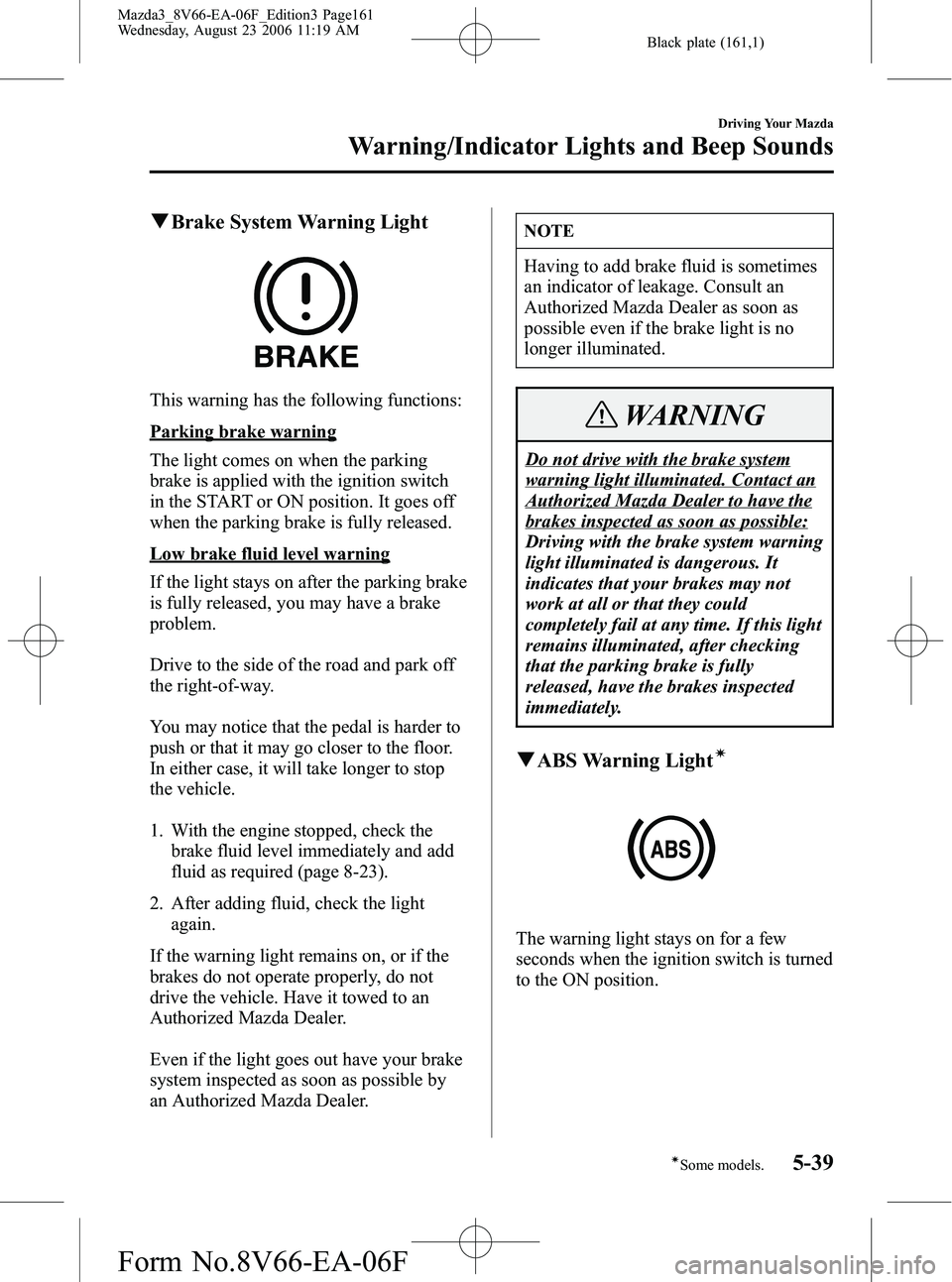
Black plate (161,1)
qBrake System Warning Light
This warning has the following functions:
Parking brake warning
The light comes on when the parking
brake is applied with the ignition switch
in the START or ON position. It goes off
when the parking brake is fully released.
Low brake fluid level warning
If the light stays on after the parking brake
is fully released, you may have a brake
problem.
Drive to the side of the road and park off
the right-of-way.
You may notice that the pedal is harder to
push or that it may go closer to the floor.
In either case, it will take longer to stop
the vehicle.
1. With the engine stopped, check the
brake fluid level immediately and add
fluid as required (page 8-23).
2. After adding fluid, check the light again.
If the warning light remains on, or if the
brakes do not operate properly, do not
drive the vehicle. Have it towed to an
Authorized Mazda Dealer.
Even if the light goes out have your brake
system inspected as soon as possible by
an Authorized Mazda Dealer.
NOTE
Having to add brake fluid is sometimes
an indicator of leakage. Consult an
Authorized Mazda Dealer as soon as
possible even if the brake light is no
longer illuminated.
WARNING
Do not drive with the brake system
warning light illuminated. Contact an
Authorized Mazda Dealer to have the
brakes inspected as soon as possible:
Driving with the brake system warning
light illuminated is dangerous. It
indicates that your brakes may not
work at all or that they could
completely fail at any time. If this light
remains illuminated, after checking
that the parking brake is fully
released, have the brakes inspected
immediately.
q ABS Warning Lightí
The warning light stays on for a few
seconds when the ignition switch is turned
to the ON position.
Driving Your Mazda
Warning/Indicator Lights and Beep Sounds
5-39íSome models.
Mazda3_8V66-EA-06F_Edition3 Page161
Wednesday, August 23 2006 11:19 AM
Form No.8V66-EA-06F
Page 162 of 402
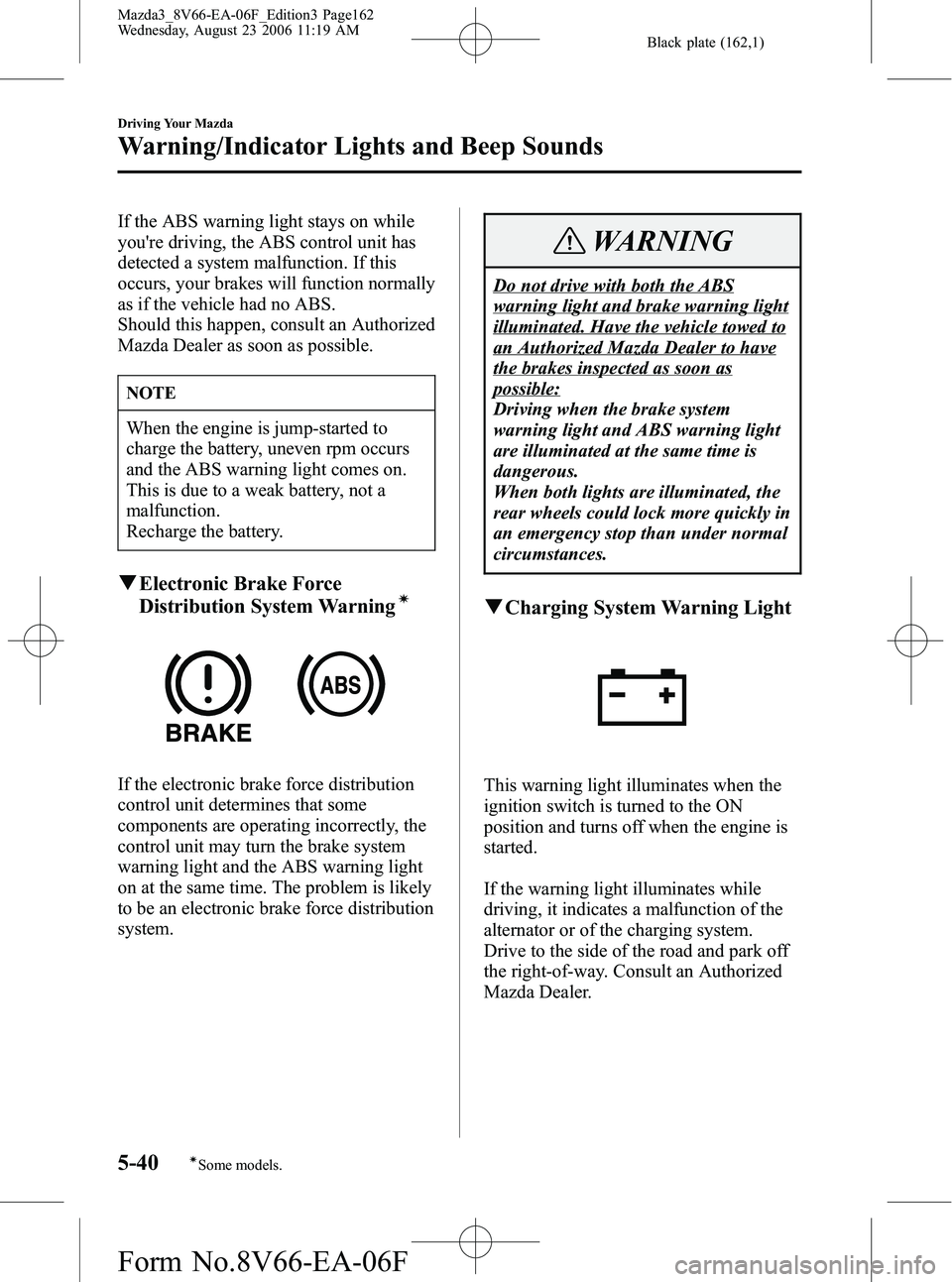
Black plate (162,1)
If the ABS warning light stays on while
you're driving, the ABS control unit has
detected a system malfunction. If this
occurs, your brakes will function normally
as if the vehicle had no ABS.
Should this happen, consult an Authorized
Mazda Dealer as soon as possible.
NOTE
When the engine is jump-started to
charge the battery, uneven rpm occurs
and the ABS warning light comes on.
This is due to a weak battery, not a
malfunction.
Recharge the battery.
qElectronic Brake Force
Distribution System Warningí
If the electronic brake force distribution
control unit determines that some
components are operating incorrectly, the
control unit may turn the brake system
warning light and the ABS warning light
on at the same time. The problem is likely
to be an electronic brake force distribution
system.
WARNING
Do not drive with both the ABS
warning light and brake warning light
illuminated. Have the vehicle towed to
an Authorized Mazda Dealer to have
the brakes inspected as soon as
possible:
Driving when the brake system
warning light and ABS warning light
are illuminated at the same time is
dangerous.
When both lights are illuminated, the
rear wheels could lock more quickly in
an emergency stop than under normal
circumstances.
qCharging System Warning Light
This warning light illuminates when the
ignition switch is turned to the ON
position and turns off when the engine is
started.
If the warning light illuminates while
driving, it indicates a malfunction of the
alternator or of the charging system.
Drive to the side of the road and park off
the right-of-way. Consult an Authorized
Mazda Dealer.
5-40
Driving Your Mazda
íSome models.
Warning/Indicator Lights and Beep Sounds
Mazda3_8V66-EA-06F_Edition3 Page162
Wednesday, August 23 2006 11:19 AM
Form No.8V66-EA-06F
Page 163 of 402
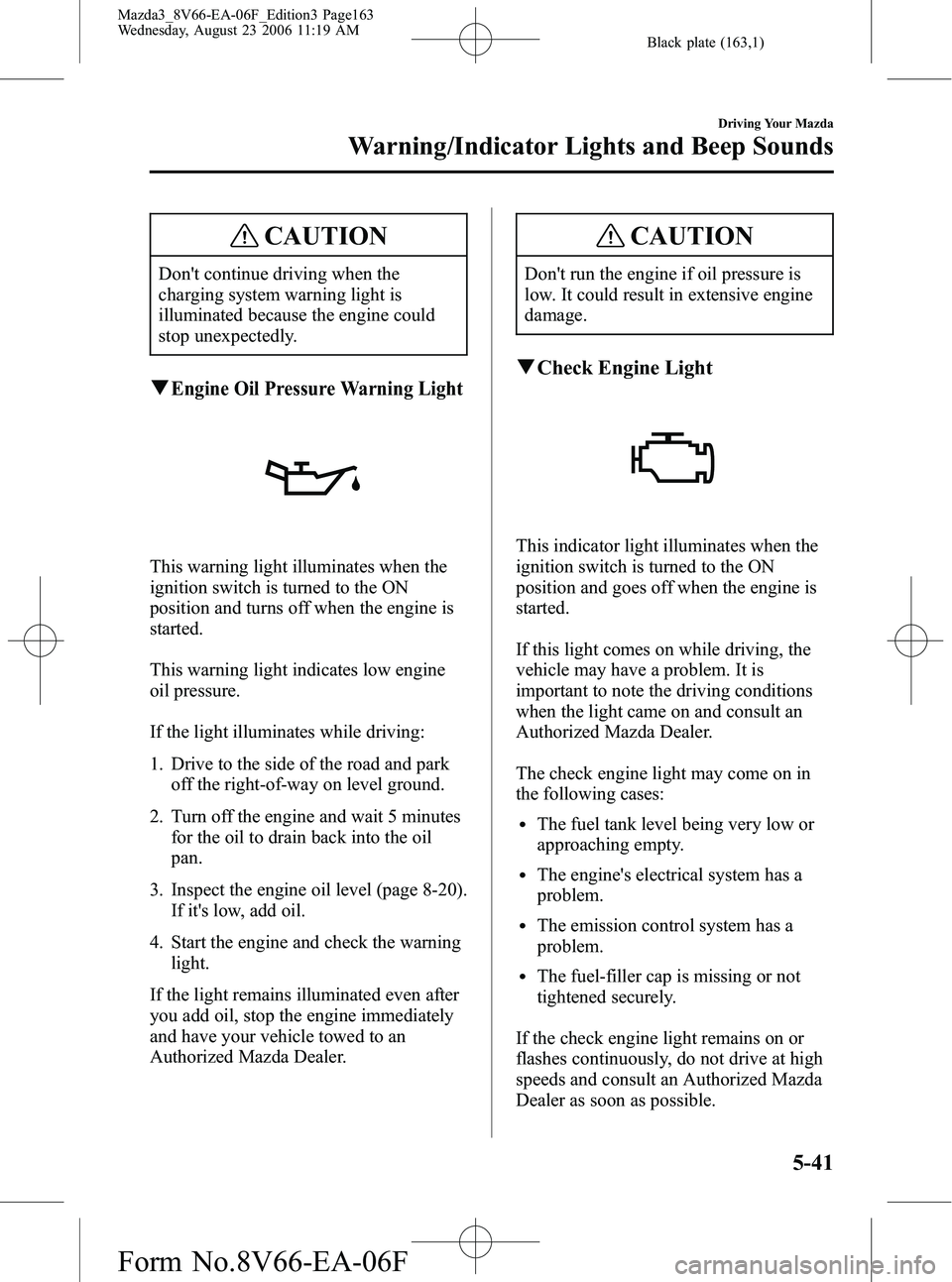
Black plate (163,1)
CAUTION
Don't continue driving when the
charging system warning light is
illuminated because the engine could
stop unexpectedly.
qEngine Oil Pressure Warning Light
This warning light illuminates when the
ignition switch is turned to the ON
position and turns off when the engine is
started.
This warning light indicates low engine
oil pressure.
If the light illuminates while driving:
1. Drive to the side of the road and parkoff the right-of-way on level ground.
2. Turn off the engine and wait 5 minutes for the oil to drain back into the oil
pan.
3. Inspect the engine oil level (page 8-20). If it's low, add oil.
4. Start the engine and check the warning light.
If the light remains illuminated even after
you add oil, stop the engine immediately
and have your vehicle towed to an
Authorized Mazda Dealer.
CAUTION
Don't run the engine if oil pressure is
low. It could result in extensive engine
damage.
q Check Engine Light
This indicator light illuminates when the
ignition switch is turned to the ON
position and goes off when the engine is
started.
If this light comes on while driving, the
vehicle may have a problem. It is
important to note the driving conditions
when the light came on and consult an
Authorized Mazda Dealer.
The check engine light may come on in
the following cases:
lThe fuel tank level being very low or
approaching empty.
lThe engine's electrical system has a
problem.
lThe emission control system has a
problem.
lThe fuel-filler cap is missing or not
tightened securely.
If the check engine light remains on or
flashes continuously, do not drive at high
speeds and consult an Authorized Mazda
Dealer as soon as possible.
Driving Your Mazda
Warning/Indicator Lights and Beep Sounds
5-41
Mazda3_8V66-EA-06F_Edition3 Page163
Wednesday, August 23 2006 11:19 AM
Form No.8V66-EA-06F
Page 168 of 402
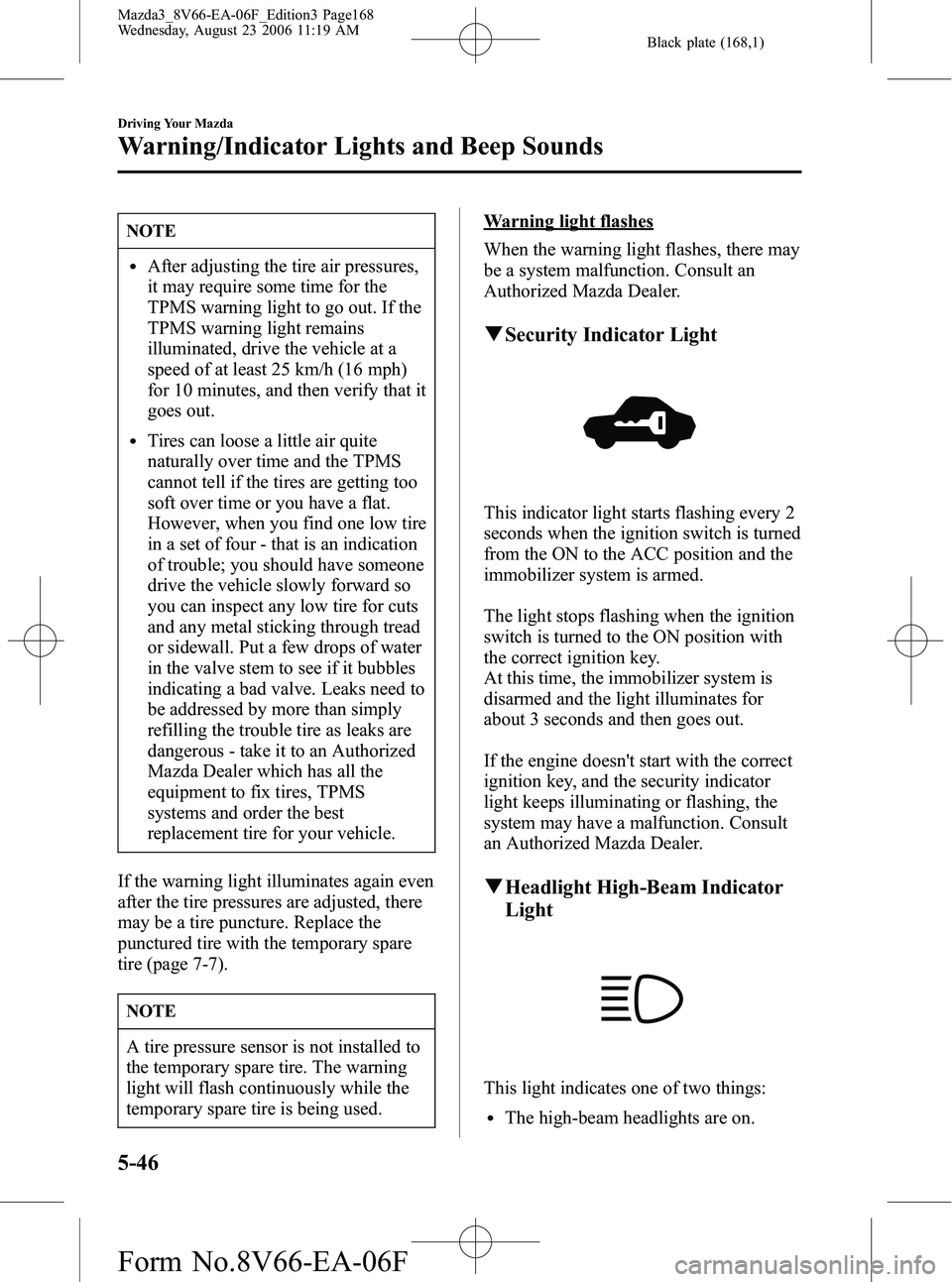
Black plate (168,1)
NOTE
lAfter adjusting the tire air pressures,
it may require some time for the
TPMS warning light to go out. If the
TPMS warning light remains
illuminated, drive the vehicle at a
speed of at least 25 km/h (16 mph)
for 10 minutes, and then verify that it
goes out.
lTires can loose a little air quite
naturally over time and the TPMS
cannot tell if the tires are getting too
soft over time or you have a flat.
However, when you find one low tire
in a set of four - that is an indication
of trouble; you should have someone
drive the vehicle slowly forward so
you can inspect any low tire for cuts
and any metal sticking through tread
or sidewall. Put a few drops of water
in the valve stem to see if it bubbles
indicating a bad valve. Leaks need to
be addressed by more than simply
refilling the trouble tire as leaks are
dangerous - take it to an Authorized
Mazda Dealer which has all the
equipment to fix tires, TPMS
systems and order the best
replacement tire for your vehicle.
If the warning light illuminates again even
after the tire pressures are adjusted, there
may be a tire puncture. Replace the
punctured tire with the temporary spare
tire (page 7-7).
NOTE
A tire pressure sensor is not installed to
the temporary spare tire. The warning
light will flash continuously while the
temporary spare tire is being used.
Warning light flashes
When the warning light flashes, there may
be a system malfunction. Consult an
Authorized Mazda Dealer.
q Security Indicator Light
This indicator light starts flashing every 2
seconds when the ignition switch is turned
from the ON to the ACC position and the
immobilizer system is armed.
The light stops flashing when the ignition
switch is turned to the ON position with
the correct ignition key.
At this time, the immobilizer system is
disarmed and the light illuminates for
about 3 seconds and then goes out.
If the engine doesn't start with the correct
ignition key, and the security indicator
light keeps illuminating or flashing, the
system may have a malfunction. Consult
an Authorized Mazda Dealer.
qHeadlight High-Beam Indicator
Light
This light indicates one of two things:
lThe high-beam headlights are on.
5-46
Driving Your Mazda
Warning/Indicator Lights and Beep Sounds
Mazda3_8V66-EA-06F_Edition3 Page168
Wednesday, August 23 2006 11:19 AM
Form No.8V66-EA-06F
Page 219 of 402

Black plate (219,1)
NOTE
The cassette tape can be ejected when
the ignition switch is in the OFF
position.
Fast-forward/Rewind
Press the fast-forward button (
)to
fast-forward.
Press the rewind button (
) to rewind.
To stop this operation and play the
cassette tape, press the button again.
NOTE
When the cassette tape ends during fast-
forward or rewind, it automatically
stops and starts playing.
Reversing
Press the program button (
)to
change cassette tape-play direction.
NOTE
When the cassette tape ends, the unit
automatically reverses play.
Automatic program control (APC)
APC is used to find the beginning of
either the next program or the one being
played.
Press the APC button (
) to the
beginning of the next selection.
Press the APC button (
) to the
beginning of the one being played. To
stop this operation and play the cassette
tape, press the button again.
NOTE
APC may not operate properly if:
lA tape was recorded at a low level.
lA tape has long, silent intervals.
lA tape is a live recording.
lA tape has very short intervals of
less than 3 seconds.
Repeat play
This operation makes it possible to listen
to a selection repeatedly.
Press the repeat button (
) during play.
The current selection playing will be
repeated ( “RPT ”will be displayed).
Press the repeat button (
) once again
to cancel repeat play.
NOTE
RPT may not operate properly if:
lA tape was recorded at a low level.
lA tape has long, silent intervals.
lA tape is a live recording.
lA tape has very short intervals of
less than 3 seconds.
Interior Comfort
Audio System
6-35
Mazda3_8V66-EA-06F_Edition3 Page219
Wednesday, August 23 2006 11:20 AM
Form No.8V66-EA-06F
Page 231 of 402

Black plate (231,1)
qMute Switch
Press the mute switch () once to mute
audio, press it again to resume audio
output.
NOTE
If the ignition switch is turned to the
LOCK position with the audio muted,
the mute will be canceled.
Therefore, when the engine is restarted,
the audio is not muted. To mute the
audio again, press the mute switch (
).
Auxiliary Input
You can connect portable audio units or
similar products on the market to the
auxiliary jack to listen to music or audio
over the vehicle's speakers.
Auxiliary jack
WARNING
Do not adjust the portable audio unit
or a similar product while driving the
vehicle:
Adjusting the portable audio unit or a
similar product while driving the
vehicle is dangerous as it could
distract your attention from the vehicle
operation which could lead to a
serious accident. Always adjust the
portable audio unit or a similar
product while the vehicle is stopped.
CAUTION
Close the cover when the auxiliary jack
is not in use to prevent foreign objects
and liquids from getting into the
auxiliary jack.
Interior Comfort
Audio System
6-47
Mazda3_8V66-EA-06F_Edition3 Page231
Wednesday, August 23 2006 11:20 AM
Form No.8V66-EA-06F